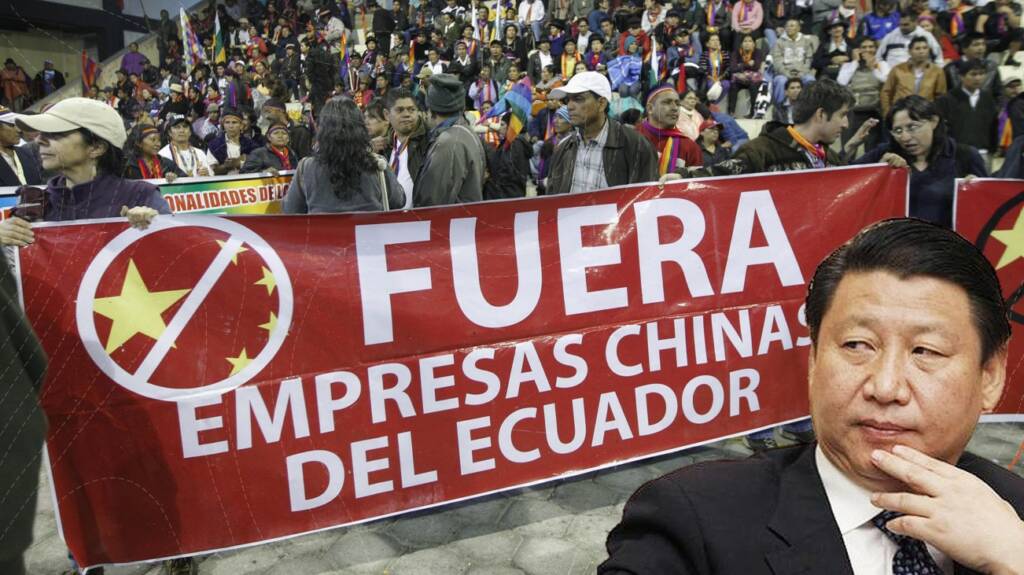- The Chinese companies adapted to local opposition by embracing strategies including illicit land grabbing, threatening locals of severe consequences, and deploying pro-mining groups to persuade local community leaders.
- The Chinese involvement in Ecuador’s mining sector has vehemently weakened the country’s social fabric and democracy.
- The Chinese companies effectively pitted Ecuadorians against Ecuadorians, sought support from non-indigenous communities who approved of Chinese mining activities
China is a copper-hungry country. China’s demand for copper has reached a whopping 12,794 metric tons per year, making it the largest consumer of the metal. To tame China’s growing hunger for copper, the communist country has placed special emphasis on Latin America, since the region holds 20.7 million tons of copper reserves, though the reserves account for only 70% of the copper located in the Chinese territory.
So, in the early 2010s, China entered the Chilean mining sector and exhausted the country’s vast copper deposits, forcing Chinese miners to look for other alternatives. And then Ecuador caught their attention that sits on 3.5 million tons of copper reserves. A Chinese-run mining consortium, which is jointly owned by the Tongling Nonferrous Metals Group and China’s national champion railcar maker, the China Railway Construction Corporation (CRCC), has been the leader of Chinese mining operations in Ecuador. In 2010, the consortium acquired the Canadian company ‘Corriente Resources’ along with Ecuador’s two largest copper deposits—Mirador and San Carlos Panantza.
The Chinese face massive local resistance in Ecuador
Much to the chagrin of Chinese miners, both of the mines are embedded in a geologically and culturally sensitive environment that holds spiritual value for the indigenous Shuar community. An estimate numbers their population to 110,000 who are located in two countries—Ecuador and Peru. They are divided into 668 communities, which tend to emphasize special care for jungles, rivers and the environment. Eventually, they organized themselves as the biggest obstacle in the path of Chinese mining operations, which in turn forced the Chinese consortium to deploy the Ecuadorian government and elites against the local communities.
Read More: From Chile to Brazil, China is losing Latin America. One country at a time
To tame the exponential opposition from the local communities, the Chinese adopted a straightforward strategy. The Chinese miners lobbied intensely in Ecuador’s capital Quito. The elite rulers, blinded by enormous commercial gains, assisted the Chinese companies by relaxing laws and norms. Mining norms got relaxed by the government that helped the Chinese miners displace the resenting communities. The Canadian predecessors focused on winning the Shuar community’s confidence; however, the Chinese consortium solely focused on devising ways to get support from the government and security forces. But this only aggravated the situation as the Shuar community grew angrier over suppression of their rights.
Chinese strategy of intimidation worked in Mirador
The Chinese companies adapted to local opposition by embracing strategies including illicit land grabbing, threatening locals of severe consequences, and deploying pro-mining groups to persuade local community leaders. For China, these strategies worked in Mirador, where the Shuar community is significantly diluted owing to the forced migration at the government’s behest. Since the commercial interests are paramount for the non-indigenous community of Mirador, the nexus of Chinese consortium and Ecuadorian governments got success in carrying out mining operations there. The Chinese companies effectively pitted Ecuadorians against Ecuadorians, sought support from non-Shuar communities who approved of Chinese mining activities and tasked them with taming the Shuar’s outrage. The plan worked and helped the Chinese miners to go ahead with the mining work.
In Panantza, Chinese ambitions bite the dust
But the same strategy failed in San Carlos Panantza. The main reason for the failure was the unity of the Shuar community. Unlike in Mirador, the Shuar residents of Panantza pushed back vigorously. Around 12000 Shuars mobilized themselves in a great deal and took back their lands from the Chinese consortium by violent means. The physical violence took a massive toll upon Chinese mining operations that remained stalled to date. The lack of mediation and adequate reparations has encouraged the emergence of armed groups near the San Carlos Panantza project, which could further deteriorate the region’s democratic climate and protection of the rights of local communities.
Read More: Africa is all set to pull the plug on China’s plan to loot the continent’s resources
The Chinese involvement in Ecuador’s mining sector has vehemently weakened the country’s social fabric and democracy. In Mirador, the Chinese miners got success in carrying out mining activities but only by crushing the local resistance. On the contrary, the mining operations never started in Panantza as the Chinese miners could not overcome the local resistance. The Chinese learnt a life lesson that winning the confidence of local communities was necessary to sustain massive projects in the countries, despite having the local governments in their own pockets.
